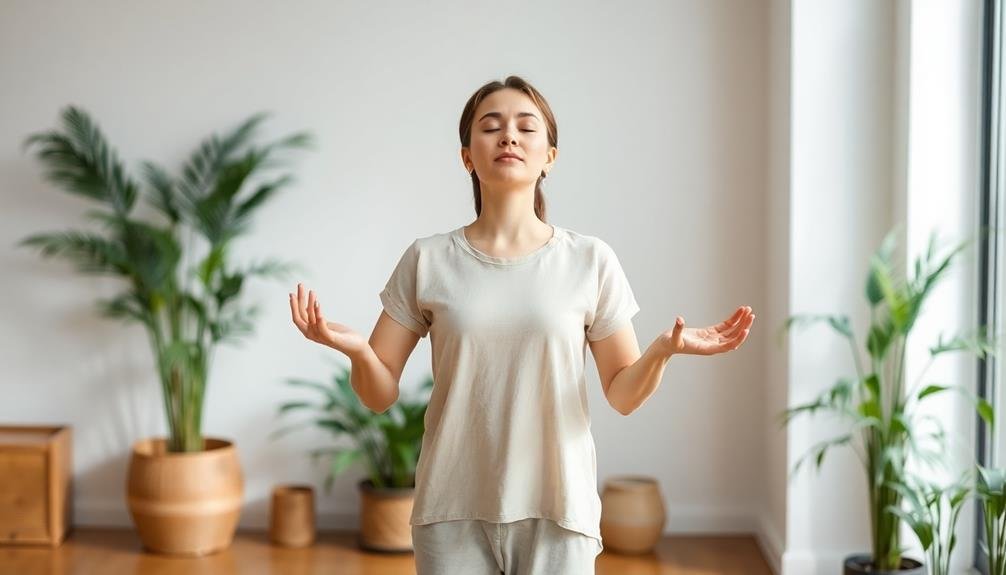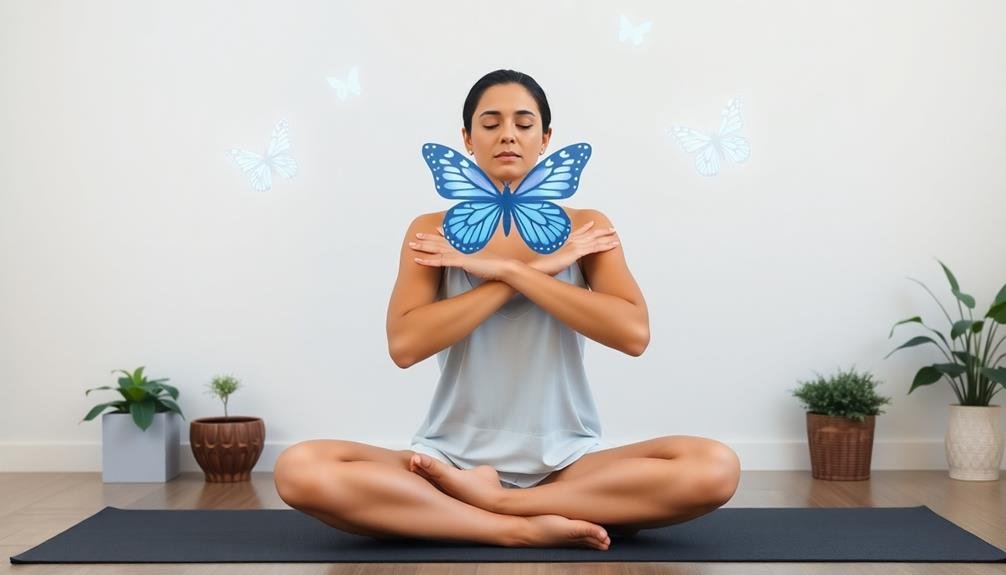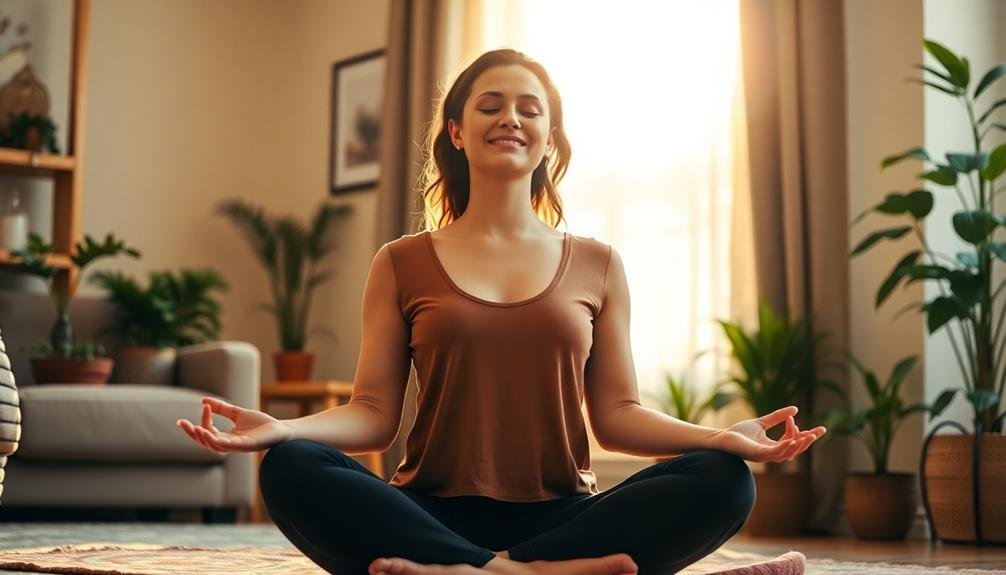You can ease anxiety naturally with these seven indoor Qigong techniques: Standing Like a Tree, Knocking on the Door of Life, Butterfly Hug, Shaking the Tree, Golden Ball Energy Cultivation, Eight Pieces of Brocade, and Inner Smile Meditation. These practices blend ancient wisdom with modern stress-relief methods, targeting both your physical and emotional states. They'll help you ground yourself, improve energy flow, and manage stress effectively. By incorporating these techniques into your daily routine, you'll stimulate your vagus nerve, encourage mindfulness, and enhance your emotional regulation. With regular practice, you'll discover a path to inner calm and better overall well-being.
Standing Like a Tree

Stillness is the foundation of the "Standing Like a Tree" qigong technique. This practice involves standing in a relaxed, upright posture with your feet shoulder-width apart and your knees slightly bent.
You'll keep your arms gently curved, as if hugging a large tree trunk. As you maintain this position, focus on your breath and imagine roots growing from your feet into the earth.
Begin with short sessions of 2-3 minutes and gradually increase to 15-20 minutes as you build stamina. During the practice, you may feel sensations like tingling, warmth, or heaviness in your body. These are normal and indicate the movement of qi (energy) through your system.
The key to "Standing Like a Tree" is finding a balance between relaxation and alertness. Allow tension to melt away while remaining aware of your posture and breath.
This technique helps calm your mind, improve posture, and enhance overall energy flow. With regular practice, you'll likely notice reduced anxiety, increased stability, and a greater sense of groundedness in your daily life.
Knocking on the Door of Life
While "Standing Like a Tree" focuses on stillness, "Knocking on the Door of Life" introduces gentle movement to stimulate energy flow. This technique targets the lower dantian, an energy center located below your navel, believed to be the source of life force.
To perform this exercise, stand with your feet shoulder-width apart and knees slightly bent. Place your palms on your lower abdomen, with fingers pointing towards each other. As you inhale, gently tap your lower abdomen with your fingertips. Exhale and relax your hands. Repeat this process for 3-5 minutes.
The benefits of "Knocking on the Door of Life" include:
- Stimulating the digestive system
- Boosting energy levels
- Reducing anxiety and stress
- Improving overall well-being
As you practice, focus on your breath and the sensation in your lower abdomen. You may feel warmth or tingling, indicating increased energy flow.
This technique is particularly effective when performed in the morning to kickstart your day or during moments of stress to recenter yourself.
Butterfly Hug

The Butterfly Hug is a simple yet powerful Qigong technique you can easily incorporate into your anxiety management routine.
You'll learn how to perform this calming exercise, understand its specific benefits for anxiety relief, and explore variations to suit your needs.
We'll also cover modifications that can make the Butterfly Hug more accessible or challenging, depending on your skill level and preferences.
How to Perform It
Performing the Butterfly Hug is a simple yet effective Qigong technique for anxiety relief.
To start, stand or sit comfortably with your back straight and shoulders relaxed. Cross your arms over your chest, placing your hands on opposite shoulders. Your fingertips should rest just below your collarbone.
Begin by taking slow, deep breaths. As you inhale, gently tap your right hand on your left shoulder. As you exhale, tap your left hand on your right shoulder. Continue this alternating pattern, synchronizing your taps with your breath. Focus on the sensations in your body and the rhythm of your breathing.
For maximum benefit, practice the Butterfly Hug for at least 5 minutes. You can increase the duration as you become more comfortable with the technique.
The Butterfly Hug offers several advantages:
- It's discreet and can be done anywhere
- It promotes bilateral stimulation, which helps calm the nervous system
- It encourages mindful breathing, reducing stress
- It provides a sense of self-comfort and grounding
Remember to maintain a gentle touch and a steady rhythm throughout the exercise. If you feel overwhelmed, pause and take a few deep breaths before resuming.
Benefits for Anxiety Relief
Practitioners of the Butterfly Hug technique often experience significant anxiety relief due to its multifaceted approach. This simple yet powerful qigong method targets both your physical and emotional state, helping to calm your mind and body simultaneously.
When you perform the Butterfly Hug, you'll activate your body's natural relaxation response. The gentle tapping on your chest stimulates the vagus nerve, which can lower your heart rate and blood pressure. This physical action helps counteract the physiological symptoms of anxiety, such as rapid heartbeat and shallow breathing.
The technique also encourages mindfulness, as you focus on your breath and the sensations in your body. This heightened awareness can interrupt anxious thoughts and bring you into the present moment.
Additionally, the rhythmic nature of the tapping creates a soothing effect, similar to that of meditation or deep breathing exercises.
Regular practice of the Butterfly Hug can lead to improved emotional regulation and stress management skills. You'll likely find that you're better equipped to handle anxiety-inducing situations, with a greater sense of calm and control in your daily life.
Variations and Modifications
While the standard Butterfly Hug technique offers significant benefits, you can explore several variations to enhance its effectiveness or tailor it to your specific needs.
One popular modification is the "Seated Butterfly Hug," which allows you to practice the technique while sitting comfortably in a chair. This variation is especially helpful if you're feeling fatigued or have difficulty standing for extended periods.
Another adaptation is the "Slow-Motion Butterfly Hug," where you perform the arm movements at a much slower pace. This modification can help you focus more intently on your breath and bodily sensations, potentially deepening the relaxation response.
For those who prefer a more dynamic approach, try the "Walking Butterfly Hug." As you walk slowly, alternate tapping your shoulders with each step. This combination of movement and tapping can be particularly grounding.
Lastly, consider incorporating visualization into your practice. As you perform the Butterfly Hug, imagine:
- A warm, soothing light enveloping your body
- Anxiety leaving your body with each exhale
- Your muscles relaxing one by one
- A peaceful, safe place where you feel completely at ease
These variations allow you to customize the Butterfly Hug technique to best suit your needs and preferences.
Shaking the Tree
Experience the powerful "Shaking the Tree" technique to release tension and ground yourself during anxious moments.
Stand with your feet shoulder-width apart, bend your knees slightly, and begin gently shaking your entire body from your feet upwards.
As you shake, visualize stress and anxiety leaving your body, allowing a sense of calm to wash over you.
Release Tension Through Movement
Shaking off stress and tension is a fundamental aspect of this powerful Qigong technique. "Shaking the Tree" involves gentle, rhythmic movements that mimic a tree swaying in the wind. As you practice this exercise, you'll feel your body releasing pent-up energy and anxiety, leaving you more relaxed and centered.
To perform "Shaking the Tree," stand with your feet shoulder-width apart and knees slightly bent. Begin by gently shaking your hands and arms, allowing the movement to spread throughout your body. As you continue, imagine you're a tree being blown by a gentle breeze, swaying back and forth.
The benefits of this technique include:
- Improved circulation
- Release of muscular tension
- Increased energy flow
- Enhanced mind-body connection
As you shake, focus on your breath and allow any negative thoughts or emotions to dissipate. You can practice this technique for 3-5 minutes or longer if desired.
Grounding and Stress Relief
The "Shaking the Tree" technique isn't just about releasing tension; it's a powerful tool for grounding and stress relief. As you practice this Qigong exercise, you'll find yourself becoming more rooted and centered.
Begin by standing with your feet shoulder-width apart, knees slightly bent. Imagine you're a tree, with roots extending deep into the earth.
Start gently shaking your body, beginning from your feet and moving upwards. Let the vibrations travel through your legs, hips, torso, arms, and head. As you shake, visualize stress and anxiety leaving your body, like leaves falling from a tree. Breathe deeply and naturally, allowing the movement to flow freely.
Continue for 3-5 minutes, or until you feel a sense of calm washing over you. You may notice tingling sensations or warmth spreading through your body – these are signs of energy flow and stress release.
As you finish, slowly come to a stop, taking a moment to feel the ground beneath your feet. You'll likely experience a renewed sense of stability and tranquility, having shed layers of stress and anxiety through this simple yet effective Qigong practice.
Golden Ball Energy Cultivation

Imagine holding a luminous golden ball of energy between your palms. This visualization is the cornerstone of the Golden Ball Energy Cultivation technique, a powerful Qigong practice for reducing anxiety and promoting inner calm. As you focus on this imaginary sphere, you're tapping into your body's natural energy flow, known as "qi" in traditional Chinese medicine.
To perform this technique:
- Stand with your feet shoulder-width apart, knees slightly bent
- Hold your hands in front of your abdomen, palms facing each other
- Visualize a golden ball of energy forming between your hands
- Slowly move your hands apart and together, feeling the energy expand and contract
As you practice, you'll notice a tingling sensation or warmth between your palms. This is your qi becoming more tangible. Breathe deeply and steadily, allowing your mind to focus solely on the golden ball.
With regular practice, you'll find it easier to summon this calming energy whenever anxiety strikes, even without the physical movements. The Golden Ball technique empowers you to cultivate and direct your internal energy, fostering a sense of control over your emotional state.
Eight Pieces of Brocade
Moving from the golden sphere of energy, we turn our attention to a set of ancient Chinese exercises known as the Eight Pieces of Brocade. This sequence consists of eight distinct movements, each designed to target specific areas of your body and mind for improved health and reduced anxiety.
You'll start by standing with your feet shoulder-width apart, breathing deeply. The first movement involves raising your arms overhead while standing on your toes, then lowering them as you exhale.
Next, you'll perform a bow-and-arrow pose, followed by raising one arm while the other presses down. The fourth movement involves twisting your torso while looking behind you.
For the fifth exercise, you'll swing your head and buttocks in opposite directions. The sixth movement focuses on touching your toes and then reaching for the sky.
In the seventh, you'll clench your fists and glare with wide eyes. Finally, you'll conclude by rising on your toes and lowering your heels seven times.
Practice these movements daily, focusing on your breath and intention, to experience reduced anxiety and improved overall well-being.
Inner Smile Meditation

From the dynamic movements of the Eight Pieces of Brocade, we shift to the serene practice of Inner Smile Meditation. This technique focuses on cultivating positive emotions and inner peace through visualization and mindfulness. You'll learn to direct a gentle smile inward, fostering a sense of calm and well-being.
To practice Inner Smile Meditation, find a comfortable seated position and close your eyes. Begin by visualizing a warm, radiant smile on your face. Allow this smile to spread throughout your body, imagining it flowing to various organs and systems.
As you practice, you may notice:
- Reduced muscle tension
- Slower, deeper breathing
- A sense of warmth or tingling
- Increased overall relaxation
Concentrate on sending loving, healing energy to areas of discomfort or stress in your body. This practice can help alleviate anxiety by promoting a positive mindset and reducing physical tension.
With regular practice, you'll develop a greater awareness of your body's sensations and emotions, allowing you to manage anxiety more effectively. Inner Smile Meditation can be done for just a few minutes daily, making it an accessible tool for managing stress and promoting overall well-being.
Frequently Asked Questions
How Long Should I Practice Qigong Daily for Anxiety Relief?
You'll benefit from practicing qigong for 15-30 minutes daily for anxiety relief. Start with shorter sessions and gradually increase. Consistency matters more than duration. Listen to your body and adjust as needed. You'll feel calmer with regular practice.
Can Qigong Be Combined With Other Anxiety Management Techniques?
Yes, you can combine qigong with other anxiety management techniques. It's often beneficial to pair it with meditation, deep breathing exercises, or cognitive behavioral therapy. You'll likely see enhanced results by integrating multiple approaches into your anxiety management routine.
Are There Any Potential Side Effects of Practicing Qigong?
You'll find Qigong generally safe, but you might experience mild dizziness, fatigue, or muscle soreness initially. If you've got existing health conditions, it's best to consult your doctor before starting. Always listen to your body during practice.
What's the Best Time of Day to Practice Indoor Qigong?
You'll find the best time to practice indoor qigong is in the morning, shortly after waking. It'll energize you for the day ahead. However, if you're pressed for time, any consistent daily practice is beneficial.
How Soon Can I Expect to See Results From Regular Qigong Practice?
You'll likely notice subtle benefits within a few weeks of consistent qigong practice. However, significant changes may take 2-3 months. Everyone's different, so be patient and focus on your personal progress rather than expecting immediate results.
In Summary
You've now learned seven powerful qigong techniques to naturally reduce anxiety from the comfort of your home. By practicing these exercises regularly, you'll cultivate inner calm and balance. Remember, consistency is key. Start with just a few minutes daily and gradually increase your practice time. As you incorporate these methods into your routine, you'll likely notice improvements in your overall well-being. Don't hesitate to explore other qigong practices to further enhance your anxiety management toolkit.





Leave a Reply